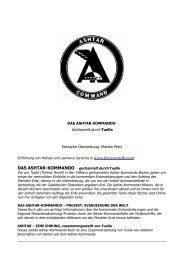ALIEN INTERVIEW - THE NEW EARTH - Earth Changes and The ...
ALIEN INTERVIEW - THE NEW EARTH - Earth Changes and The ...
ALIEN INTERVIEW - THE NEW EARTH - Earth Changes and The ...
You also want an ePaper? Increase the reach of your titles
YUMPU automatically turns print PDFs into web optimized ePapers that Google loves.
Kubrick film from 1964, Dr. Strangelove or: How I Learned to Stop Worrying <strong>and</strong> Love the<br />
Bomb. It is also a main topic of the movie Beneath the Planet of the Apes, in parallel with the<br />
species extermination theme. Most such models either rely on the fact that hydrogen bombs<br />
can be made arbitrarily large (see Teller-Ulam design) or that they can be "salted" with<br />
materials designed to create long-lasting <strong>and</strong> hazardous fallout (e.g.; a cobalt bomb).<br />
<strong>The</strong>re are many unconfirmed, anecdotal reports of a Soviet doomsday device involving a<br />
200-megaton hydrogen bomb sheathed in (or, alternately, "salted" with) a highly radioactive<br />
material, usually said to be cobalt, of sufficient quantity to saturate the earth's atmosphere<br />
with deadly fallout should the device be detonated. Details regarding this device vary<br />
according to the source, but enough similarities in the dozens of different stories exist to<br />
suggest at least some basis in truth. According to various sources, at some point between<br />
1967 <strong>and</strong> 1985, the device was designed but never constructed; built but never activated;<br />
built <strong>and</strong> activated, but dismantled at the end of the cold war; or designed <strong>and</strong> constructed in<br />
such a manner that it can never be de-activated, <strong>and</strong> is still in existence today. Tales of its<br />
location <strong>and</strong> means of operation are equally diverse: it was in an underground bunker west<br />
of Moscow, Siberia, the Ukraine, etc.; it was installed on a special rocket booster that would<br />
deliver it to the upper atmosphere upon activation; it was actually a series of bombs placed<br />
at intervals along the western border of the USSR; it was to be detonated upon comm<strong>and</strong><br />
from the Kremlin, automatically by a special computer, a seismic trigger, or upon detection of<br />
incoming missiles. Many more versions exist, such as one with the device being<br />
permanently installed in the hold of an unmarked tramp freighter, steaming r<strong>and</strong>omly from<br />
port to port in the North Sea."<br />
-- Reference: Wikipedia.org<br />
218 "... paradigm..."<br />
"Historian of science Thomas Kuhn gave this word its contemporary meaning when he<br />
adopted it to refer to the set of practices that define a scientific discipline during a particular<br />
period of time. Kuhn himself came to prefer the terms exemplar <strong>and</strong> normal science, which<br />
have more exact philosophical meanings. However, in his book <strong>The</strong> Structure of Scientific<br />
Revolutions Kuhn defines a scientific paradigm as:<br />
• what is to be observed <strong>and</strong> scrutinized<br />
• the kind of questions that are supposed to be asked <strong>and</strong> probed for answers in<br />
relation to this subject<br />
• how these questions are to be structured<br />
• how the results of scientific investigations should be interpreted<br />
Alternatively, the Oxford English Dictionary defines paradigm as "a pattern or model, an<br />
exemplar."<br />
-- Reference: Wikipedia.org<br />
219 "...Nicola Tesla..."<br />
"Nikola Tesla (10 July 1856 – 7 January 1943) was an inventor, physicist, mechanical<br />
engineer, <strong>and</strong> electrical engineer. Born in Smiljan, Croatian Krajina, Military Frontier, he was<br />
an ethnic Serb subject of the Austrian Empire <strong>and</strong> later became an American citizen. Tesla<br />
is best known for his many revolutionary contributions to the discipline of electricity <strong>and</strong><br />
magnetism in the late 19th <strong>and</strong> early 20th century. Tesla's patents <strong>and</strong> theoretical work<br />
301





